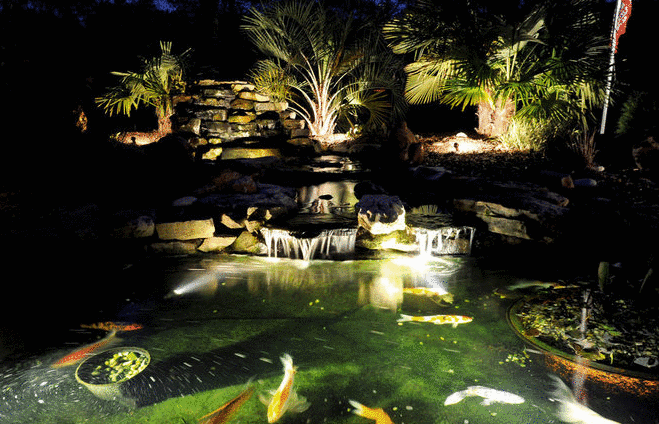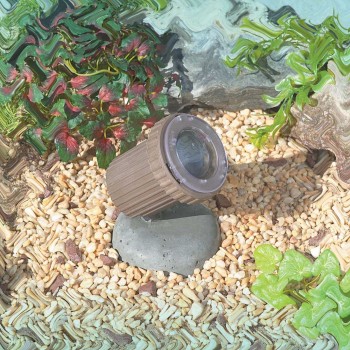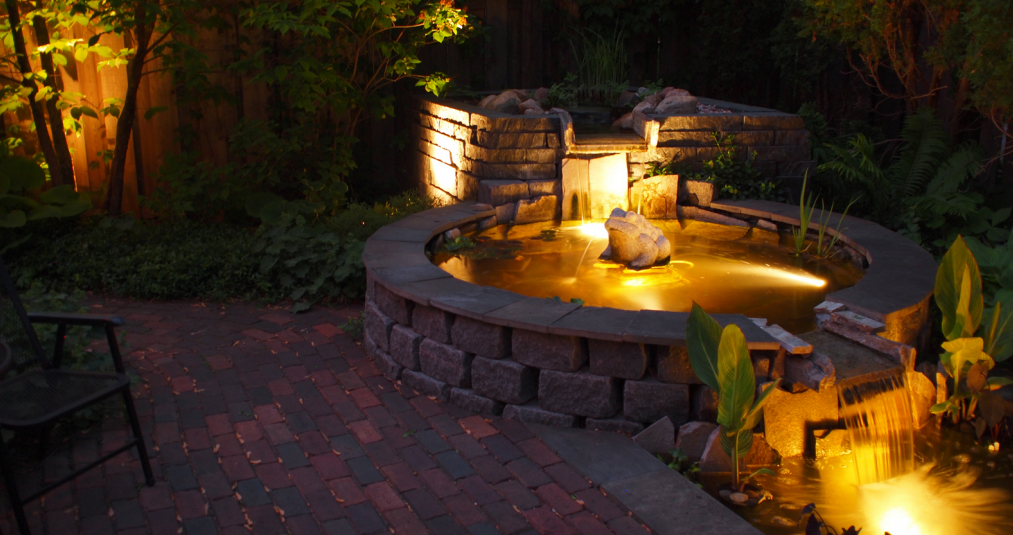
Capture night time magic with the addition of quality underwater lighting
- By Clarissa Allison | April 24th, 2015
If you are looking for a place to escape from life’s every day hustle and bustle, lighting your backyard pond or water garden can transform the setting into your own personal storybook retreat or exotic getaway.
Consider the Possibilities
A primary consideration to begin with involves your existing outdoor landscape and any current lighting installations you may have now. How do you want your new pond lighting system to complement the surroundings? Consider the style of the fixtures and lighting effects you wish to add to your feature and whether they will integrate well. Think about what you wish to highlight with your lighting project. Do you want guests to admire your koi pond, a splendid waterfall, fountain, or sculpture? When choosing lighting, are you attracted to an earthy glow or the drama of vibrant, striking colors?
Safety First
During your planning stage, meet with a qualified electrician to ensure that your circuitry is approved for above ground and underwater lighting. If you have an extensive lighting plan for future installations, make sure you include these details to avoid having to rework the design for changes again.
Lighting fixtures placed under water must be specific for such use. Look for IP (Ingress Protection) rated fixtures that are waterproof, meaning dust-tight and protected against long immersion in water, rather than simply “water safe” or “wet location safe” options. Waterproof fixtures are meant to be submerged and will prevent water from entering them due to sealed assembly. Take the precaution to ensure that your fixtures will meet all safety and application standards for an underwater environment prior to purchase or installation.
Below, we’ve detailed the most commonly used IP codes and what they represent.
(Source: International Electrotechnical Commission)
Ingress Protection (IP) ratings specify the environmental protection the enclosure provides.
The IP rating normally has two (or three) numbers:
- Protection from solid objects or materials (ex. dust)
- Protection from liquids (ex. water)
- Protection against mechanical impacts (commonly omitted, as the third number is not a part of IEC 60529)
Example – IP Rating:
With the IP rating IP 54, 5 describes the level of protection from solid objects and 4 describes the level of protection from liquids.
An “X” can used for one of the digits if there is only one class of protection, i.e. IPX1 which addresses protection against vertically falling drops of water e.g. condensation.
IP First number – Protection against Solid Objects
- 0 – No special protection
- 1 – Protected against solid objects over 50 mm, e.g. accidental touch by persons hands.
- 2 – Protected against solid objects over 12 mm, e.g. persons fingers.
- 3 – Protected against solid objects over 2.5 mm (tools and wires).
- 4 – Protected against solid objects over 1 mm (tools, wires, and small wires).
- 5 – Protected against dust limited ingress (no harmful deposit).
- 6 – Totally protected against dust.
IP Second number – Protection against Liquids
- 0 – No protection.
- 1 – Protection against vertically falling drops of water e.g. condensation.
- 2 – Protection against direct sprays of water up to 15o from the vertical.
- 3 – Protected against direct sprays of water up to 60o from the vertical.
- 4 – Protection against water sprayed from all directions – limited ingress permitted.
- 5 – Protected against low pressure jets of water from all directions – limited ingress.
- 6 – Protected against temporary flooding of water, e.g. for use on ship decks – limited ingress permitted.
- 7 – Protected against the effect of immersion between 15 cm and 1 m.
- 8 – Protects against long periods of immersion under pressure.

This beautiful pond is brought to life by the warmth of a few subtle lights that seamlessly blend into its existing structure
Voltage Requirements
When weighing your options on which type of fixture to choose, cost, convenience, and the size of your project are important. If one were to complete a large project for the grounds of a grand hotel, for example, line voltage (120V) would be the ideal option as vast distances may exist between the focal point and the fixture itself.
While it’s also true that standard incandescent bulbs can be found at virtually any hardware or household goods store, in an age where environmental awareness is important to daily life, technology and the public are moving in tandem towards different solutions. Since line voltage lighting consumes much more energy and will typically require the expertise of a licensed electrician, more homeowners are choosing low voltage (12V) options. Low voltage fixtures are notably the safer and less hazardous of the two choices, are often smaller, and easier to conceal within a natural landscape. They also have the added benefit of lower cost over time. Note that a transformer is required to convert to the lower voltage for fixtures which will be used underwater. You may also make use of photocells and timers to save on electricity consumption costs even further.
Let’s take a look at some examples of the different types of submersible low voltage products available today:
Low Voltage Halogen

Hadco Lighting UWUL516- Micro Underwater Bronze
This bronze composite underwater fixture (part number UWUL516) by Hadco Lighting is a popular low voltage and submersible choice. It features twist-off operation for ease of maintenance and accepts a 50W maximum MR16 bi-pin lamp. Additional details include an STWA water-resistant cord, and Teflon coated wire leads. The light is mounted to weighted concrete with a swivel that allows for rotation up to 90°. A remote transformer is required for proper functionality, and they are sold separately here.
The Hunza Pond Lite is fully submersible and supplied with a 9” submersible cable. The luminaire is ideal for illuminating all of your water features. The fixture can be placed in your pond without drilling fixing holes to mount it when you opt for the weighted version. This luminaire is constructed of aluminum with a UV stable powder coated finish, solid copper or 316 stainless steel with a clear, tempered, flush glass lens and high temperature silicon gaskets.
The Hadco Lighting UWL1-A Underwater Spread light is made of molded Lexan composite, and internally weighted. A single-piece molded silicone gasket prevents water, dust, and insect filtration. An optional reflector to block uplight is available. The 10W T3 lamp is included with this fixture. Lower wattage lamps are also acceptable.
Low Voltage LED
LED lights consume approximately 75% less power than incandescent units for the same amount of light output. This amounts to a sizeable savings over their life span. Moreover, standard underwater LED fixtures consume about 1/5 of the power as standard incandescent bulbs!
Besides energy savings, the nature of LED production makes them ideal for underwater applications. There are no bulbs to change as LED fixtures typically come in a permanently sealed housing. Sealed construction means underwater lights may be left in a permanent location with no concerns about extra cable allowances, or making provisions to change bulbs. They should, however, be accessible in order to clean the lenses during regular pond maintenance.
Another adjustable underwater light, the Atlantis-1407, by Lumiere Lighting is available in both 75W MR-16 and an LED version. This fixture showcases a quick-release mechanism for easy re-lamping out of the water. Create multiple underwater lighting effects with its dichroic filters and lenses. For use in fresh water only.
The Hadco Lighting ULW5D4 LED Underwater Light is an excellent LED option that is cool to the touch, ideal for traffic and plant life. This fixture comes equipped with a standard 10 ft. 18-2, 105° C, STWA water-resistant cord. It boasts an internal surge protector and is sealed against direct jets of water and against continuous submersion in water tested to 1 meter. This light requires a low voltage LED transformer, sold separately. Take a look at Louie Lighting’s selection of LED transformers here.
Do you have pictures of your water garden masterpiece? We’d love to see them! Email us at info@louielighting.com to be featured on the site.





My wife and I are thinking about installing some lights for our backyard pond soon. I like that you recommend using low voltage lights to save on energy and are safer for use in general. I think having smaller lights would also be nice because they are easy to move and can be hidden in the yard. I'll have to look for some around 12V lighting options. Thanks for sharing!